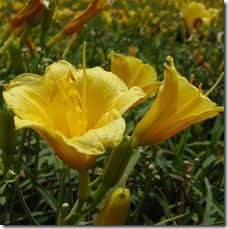-
Daylilies are the common-sense gardener’s best friend. The least-experienced gardener would be hard-pressed to make a mistake with daylilies — sunlight, water and well-drained soil are all they need to shine. Their undemanding character lasts all year; they will patiently — staying green — until all the showy floral prima donnas have been tucked in, before preparing for their long winter’s nap.
Grooming
-
Cleaning out dead foliage encourages small critters to look elsewhere for shelter.
Grooming differs for dormant and evergreen type daylilies. Spent scapes — the branched flower stalks — should be removed as flowers fade. Dormant daylilies, whose foliage browns in winter, can be trimmed back after leaves have died. Avoid damaging the crown by cutting leaves back with a sharp knife rather than by pulling them from the plant. Leave 4 to 6 inches of foliage; this protects the crown from rot and other fungal infections that attack at ground level.
Evergreen daylilies behave as though dormant in Northern growing zones, but in some parts of the South, they keep their leaves all year long. These plants need only to have individual leaves removed as they fade; new leaves grow from the center of the fan, so removing outer leaves improves the plant’s looks. Many evergreen varieties die back for a "cooling period" in late winter and may be cut back as though dormant. Remove decaying foliage to deny shelter to rodents and insects that may carry viruses or eat crowns and roots over the winter.
Mulching
-
 Straw or other light mulch protects daylily roots.
Straw or other light mulch protects daylily roots.Daylilies benefit from light winter mulch; it protects roots against drying winds in the North and keeps the ground cool in the South. Straw, wood chips or pine needles make good insulation without limiting air circulation. Bill Jarvis, a Houston hybridizer, suggests surrounding clumps with collars made from the tops of 5-gallon plastic pots to keep mulch away from crowns. Mulch against the crown allows fungus and insects a place to overwinter. Riemann Gardens at the Iowa State University suggests that although mulch is important for dormant daylilies’ first winter, hardy varieties often need no mulch in following winters, though less hardy varieties should receive mulch each winter. In areas that do not receive early snow cover, mulches should be supplemented throughout the winter if disturbed by foraging creatures.
Water
-
 Monitor moisture as ground freezes and thaws throughout winter.
Monitor moisture as ground freezes and thaws throughout winter.Daylilies need an inch of water a week. They call for more frequent watering in sandy soil, but too much water encourages crown rot and fungus infections. Dormants need water through the time the ground freezes if they have been divided in the fall; otherwise, they do just fine on natural precipitation from fall into winter. Evergreen and semi-evergreen forms in the South, need water as long as they are growing throughout the winter. Where winter brings snow cover, daylily plantings should be located so plants never sit in water as snow melts. As winter fades, monitor precipitation carefully; healthy flowering depends on an ample early supply of water.


Deprecated: strpos(): Passing null to parameter #1 ($haystack) of type string is deprecated in /home/agriviek8Qv/agriviet.net/public_html/wp-includes/comment-template.php on line 2522